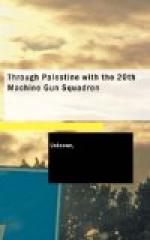THE APPROACH-MARCH TO BEERSHEBA.
The “going” was, most of the way, through thick sand with a lot of green scrub. Doubtless, everybody who took part in that march will ever remember the incidents and details of the operations—and the indescribable dust. Temperature very cold; “loads off”; “loads on”; at frequent intervals. So—on, through the night; generally at the walk, occasionally trotting; hearing, at one point, intermittent rifle-fire (on the left flank), and, with now and then, “VERY LIGHTS” being put up. Later on, a white stone building was passed (apparently unoccupied) called “Ibn Said”.
After several hours’ marching, a road and a narrow gauge Turkish railway were crossed, both of which were understood to lead to Beersheba. At length, the position was reached on Itwail El Semin, 7 miles south of Beersheba, just before daybreak, where the transport ("A” Echelon) soon found us. “A” and “B” Sub-sections were immediately attached to the “S.R.Y.” and “S.N.H.” respectively, and took up positions in front of Ras-Hablein and Goz-el-Naam.
It was not long before it became evident that there was “something doing”. Yes, the great event for which the Squadron had been preparing since its formation was about to take place! The 7th Mounted Brigade found itself “up against” a series of strongly-held trenches on Ras-Hablein to Ras-Ghannam. The 60th Infantry Division was on its left and the Australians on its right. The plan of attack, as given in the official publication: “A Brief Record of the Advance of the Egyptian Expeditionary Force” was as follows:—
“... for the 60th and 74th Divisions to seize the enemy works between the Khalasa Road and the Wadi Saba, while the defences north of the Wadi were masked by the Imperial Camel Corps Brigade and two battalions of the 53rd Division. The Anzac Mounted Division, Australian Mounted Division and 7th Mounted Brigade were to attack the defences of the town from the north-east, east and south-east”.
The progress of the attack all along the line could be seen from the top of Itwail. The Turk, everywhere, clung tenaciously to his main positions. During the whole morning and afternoon, rifle and shell-fire were continued on both sides. “B” Sub-section covered the advance of the “S.N.H.” The Essex Battery R.H.A., in action at this time, came in for a bad quarter of an hour, but fortunately escaped with slight casualties, when, at 16.00 (4 p.m.) orders were issued to attack Beersheba!
The Brigade at once formed up in a cloud of dust, and, led by its General as if on a ceremonial parade at home, started off at the trot to the attack. Soon, the dust became so dense (especially in the centre of the Brigade), that it was impossible to see two yards in front. After going a mile or two, a halt was made under cover of a hill for a few minutes, then on again. To the surprise of everyone, little opposition was now offered, and it soon became apparent that the Turk had fled, although reinforced during the day, the sight of an English Cavalry Brigade advancing, proving too much for him! Another halt, another trot, then the position was taken!




